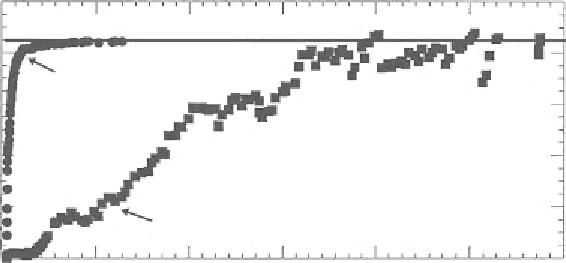Biomedical Engineering Reference
In-Depth Information
500
Baseline value
400
Expected values
without biodegradation
300
200
100
Measured values
0
0
7
14
21
28
35
42
Elapsed Time (days)
Figure 8.3. Long-term performance of the biofilter inferred from TCE measurements on the
extracted fluid with bioaugmentation of Methylosinus trichosporium OB3b for its biocatalytic
potential (from Duba et al.,
1996
).
of 425
m
g/L. About 20 g of TCE was transformed, which represented about 40% of the TCE
that passed through the biofilter. Based on laboratory studies, the injected biomass had the
potential to transform 420 g of TCE.
DO concentrations remained at about 5 mg/L, but at some locations decreased to about
1 mg/L, which was likely problematic for TCE transformation. Reasons for the reduced
performance were not identified, but were likely associated with reduced enzyme activity, a
reduction in the attached bacterial population, reduced transformation capacity in the natural
environment, or the low DO levels. The authors did not believe that it was related to grazing by
protozoans based on their enumeration, which represented about 2% of the total numbers on
day 38. No attempt was made to enhance oxygen addition to the subsurface, which may have
helped performance. Although TCE transformation of 98% was demonstrated, TCE was
removed to below regulatory levels for only 2 days, although in the laboratory testing removal
to below these levels continued for several weeks (Tompson et al.,
1994
;HannaandTaylor,
1996
).
8.4.1.4 Bioagumentation with
Burkholderia cepacia
ENV435
Another field study evaluated a biofilter of resting cells capable of cometabolic transfor-
mation of TCE. In this case, an adhesion-deficient strain of
Burkholderia cepacia
ENV435 was
used. ENV435 has the ability to transform chlorinated ethenes in the absence of an inducing
cosubstrate (Steffan et al.,
1999
) because it produces toluene
o
-TMO constitutively (Munakata-
Marr et al.,
1996
). The variant selected was adhesion deficient, facilitating transport further
into the aquifer after injections (DeFlaun et al.,
1998
).
The adhesion-deficient mutant strain ENV435 was obtained by passing cells of strain
Burkholderia cepacia
G4 PR1
301
through columns packed with sediment from Savannah
River or Roseland aquifer sediment (DeFlaun et al.,
1998
). After passing the cells through
the sand columns six times, the percentage of PR1
301
retained on the column decreased from
100% to 34%, while 80 to 93% of the wild type G4 or the parent strain of G4 were retained.
Transport studies with the selected strain in sand and sediment columns showed the wild type
strain of G4 was retained or highly retarded, while ENV435 was transported like the conserva-
tive chloride tracer. Using hydrophobic interaction chromatography, DeFlaun et al. (
1998
)
found that G4 was significantly more hydrophobic than ENV435. The highly active ENV435
was grown to have storage polymers (high-energy polyalkanoate) to drive the cometabolic

Search WWH ::

Custom Search